The Sailing
The 200 is a five-day, 40 mile a day event. 40 miles is a long way to sail at 4 or 5 miles per hour. The first day ends either at the jetties at the cut thru the barrier island at Port Mansfield, for those who sail outside in the Gulf the first day, or in the harbor at Port Mansfield for those who elect to sail inside and who prefer not to make a long beat to windward to get out to the jetties to join the campers. At Port Mansfield, you can sleep aboard if you have the accommodation or stay in a convenient hotel, with BATH and a nearby watering hole, or restaurant, if you prefer. My grandson and I stayed in the hotel.
The sailing the first day started out with a relatively gentle breeze and the wind strengthened during the day. We started out under full sail and reefed as the wind became stronger. I sailed almost all of the trip. Douglas, my grandson, has never really sailed before and during our one sail before leaving Colorado I must admit I was impatient with him and he was disinclined to receive any more abuse from his irascible captain. It took a while to sort out all the halliards and reefing lines at the mast and when shaking out a reef we had to take care to free the reefing lines to eliminate wrinkles in the sail. Doug got better and better at the job as he became familiar with the maze of lines and the reefing/shaking out went more and more quickly.
By the time we arrived at Port Mansfield the wind was quite strong, we were reefed right down (two reefs in the main and flying the little jib) and it was a bit rough as we turned to enter the harbor. I had previously arranged for a county-owned slip for the Lido and we had a reservation at the Sunset Hotel and the lady manager fulfilled her promise to come and get us at the dock and drive us to the hotel. Great service indeed! After dinner at the Windjammer Restaurant, we had a good night's sleep.
The second day the wind rose in the afternoon and during a particularly strong gust the poor choice of material for the new tiller brought its consequences home to us and the tiller broke off in my hand. We were quickly blown ashore in the shallows. During the incident we jibed accidentally and some water came aboard and while we got things sorted out and the boat bailed out a couple of guys stopped in their Bolger "Light Schooner". We were on a lee shore. They simply got their leeboard and rudder blade up and grounded near us. They were very helpful. I reversed the tiller, put the little end into the rudder head, packed with a little bit of light line to get a better fit and I thought that as long as I held the tiller back, into the rudder-head, we could continue. Getting off the lee shore was my greatest concern. The wind was striking the shore at an angle. We asked the schooner-men to turn us around and give us a bit of a shove, which they did, with a will. With just a tiny bit of board and a little bit of the rudder blade, the Lido hauled off without difficulty and we continued to the end of the day's sail, a location called "Hap's Cut", where the mud at the water's edge (there is only about 6" of tide in the waterway) is 12" deep and it'll take your shoes off and not give 'em back if you're not careful.
At the waters edge, having landed not five minutes before, a couple of the other participants came down and said, "We understand you have broken your tiller. What can we do to help?" When I removed the rudder, these guys took it and we walked down the beach to where another of the sailors was beached. He had with him a box FULL of stainless fittings in a wide assortment, a cordless drill, a cordless SAWZALL, and, miracle of miracles, and old wheel-barrow handle! Talk about helpful! In and hour I fit the handle to the rudder head and, suffice to say, we were able to complete the T200 without further trouble. This demonstration of forethought and generosity I will never forget.
 |
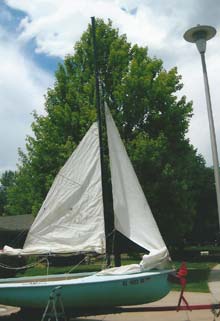 |
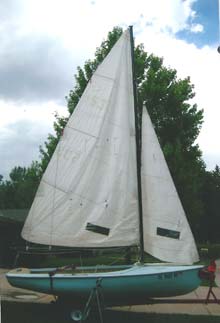 |
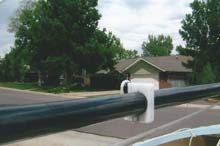 |
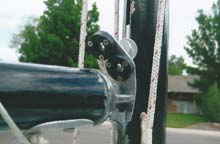 |
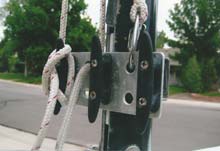 |
The third day was relatively uneventful except our arrival at the Padre Island Yacht Club where we were to be guests of the club. As is often the case, things can get a little dicey when the wind is hooting and there is "hard property" close at hand. Although we were deeply reefed, our speed was substantial while we tried to maneuver to a dock, so I sailed up to windward of our goal and Douglas took off the last remnants of sail. Even with nothing but the windage of the mast driving us we were moving pretty rapidly when we entered one of the club's big slips where, thanks to our good fortune, one of the club volunteers was able to stop us with his feet. We were looking forward to spending the evening and night at the club, which organization has welcomed the participants of the T200 for several years and they provided everyone with a very good $10 hamburger-and-fixin's dinner, along with $1 beer and other cold drinks. Plus, we were welcome to use the showers and camp anywhere we wanted to on the grounds, even inside the air-conditioned building.
The fourth day we and many of the others elected to sail up to windward, toward the barrier island, to minimize the wave-making capability of the wind, this as an alternative to sailing across the mouth of Corpus Christi Bay, with considerable "fetch" to windward and the resulting bigger sea. This meant that we were out of the intracoastal waterway for miles and the water is very shallow. There's nothing like a center-board to let you know when you're in the shallows and we touched the rudder often as well. This day the destination for camping was a place called "Paul's Mott". Shortly after we arrived, two fellows in an O'Day "Day SailerII" capsized within a quarter mile of the destination beach. The sailors are experienced but not very physically fit and the boat filled anyway and they needed lots of help and they got it.
Paul's Mott is really an idyllic, although primitive, camp site and it was there that two of the sailors were married!. They had met on the T200 a couple of years before and wanted to be married there. One of the sailors is a minister (and boat builder), there was cake, the minister wore a robe and a grand, tall mitre that made him look like the Grand Wizard of the KKK, the girls had grass skirts, there were leis for everyone, and Champaign! Another unforgettable element of the 2012 T200!
The fifth day was, perhaps, a little anti-climactic, but mercifully uneventful, at least for Douglas and me. When we arrived at Sea Drift, Texas, where our trailers were parked, the town feted us with an excellent $10 "shrimp boil", with plenty of free drinks.
The road back to Denver was still about 1200 miles long.
Suitability of the Lido
Is a Lido 14 suitable for this kind of dinghy cruising? Absolutely! But the ability to reef is of paramount importance.
What changes would I make in that Lido in order to go again? In preparation for the impending sale of the boat, I made a new tiller out of a beautiful piece of ash, so that's done. One of the members of the Lido organization recommended that I add flotation forward and reinforce the boom. I didn't do either of these, although our substantial dry-bags could be considered as added flotation. As to the boom, the vang attachment is surrounded by evidence of galvanic corrosion, which would serve to emphasize the need for reinforcement, but we were not racing and we were not stressing the vang much at all. Luckily, perhaps, the boom survived.
What complaint about the Lido's behavior? We were sailing with the wind from abeam, to starboard, back to dead astern. Steering was not easy. The boat "rooted" a good deal, with alternating heavy pressure on the tiller to starboard and then to port. This may have been because of the loading of the boat, although the total added weight was probably no more that the weight of a third occupant. Douglas and I together weigh about 350 pounds. This steering difficulty was tiring to deal with. Perhaps some of the skilled Lido sailors can identify the cause.
As an added note, we never hiked out nor sat out. We adjusted the amount of sail. One objective I had was to avoid capsize. I chose to wear my hearing aids all the way. To capsize would have meant the probable loss of these $5000 instruments.
|










